Earring Style Guidebook: Everything You Need to Know About the Different Types of Earrings
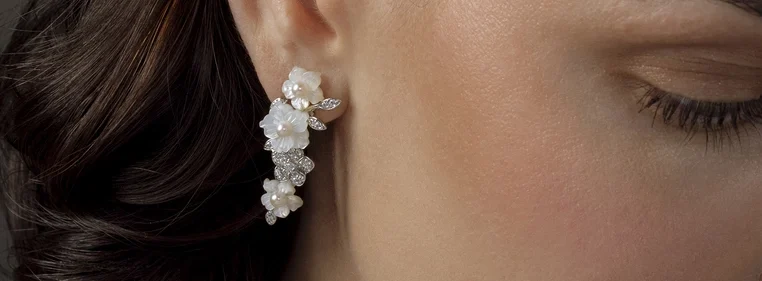

Earrings have been around since ancient times – and they’re still going strong. From minimalist studs to dangly drop earrings, adorned with clear, colorful or black gemstones, there is a wide selection of styles and designs on the market. Discover dainty and discreet pieces, bouncy and ornate earrings, oversizes statement pieces, or industrial barbells. Each come with their own range of characteristics and charm, specific backing types, and even specific placements on the ear.
Read on to find out everything you need to know about this popular type of jewelry. Next, we’re looking at the various types of earrings available today. We’ll explore their design, backing types, ear piercings, plus a brief peek into the history of earrings.
Earrings have been worn for thousands of years. Most sources indicate that they originated in ancient Asia, and depending on the area, earrings signified different statuses, occupations, and affiliations at different moments in history.
The first pierced earrings seem to originate in the Middle East, around the year 3,000 B.C. Their role was to mainly signify the wearer’s political and religious beliefs. In places like Egypt, earrings were worn by the elite classes as a status symbol, in order to indicate their position in society. On the polar opposite, in places like ancient Rome and Greece, earrings were worn by slaves or sex workers. However, the wealthier class in Rome or Greece also wore earrings with pearls and other valuable gemstones in order to signify their upper social status.
During the Bronze Age in Greece, hoop earrings gained a lot of popularity, mainly the styles featuring pendants. And during the Persian Empire, men soldiers used to wear a single earring. This was often depicted on carved walls found on archeological sites. Persians regarded jewelry pieces as talismans that could offer protection in battle.
A variety of colored gemstones were introduced as a way to ornate earpieces in the second century A.D.
During the 13th century, the Catholic church banned piercings. They were seen as an alteration of one’s sacred body. At the same time, earrings began to be fully embraced by pirates and thieves and commonly worn by men dedicated to a life of crime.
During the Middle Ages in Europe, the fashion and hairstyles of the time pushed earrings into obscurity. Earpieces were not visible due to high collars, voluminous locks, and hats. The same phenomenon occurred during the 1800s as well, when the ultra-fashionable bonnets worn by high-society ladies made earrings invisible or seldomly used.
Earpieces gained more popularity during the early 1900s when the fashionable hairdos of the era (mostly updos such as chignon) allowed for earrings to be seen and admired. Their popularity was strengthened by the introduction of clip-on earrings. These were considered more sanitary and less rebellious than pierced types, which were even regarded as vulgar during the Victorian Era.
In the United States, pierced earrings gained high regard only during the 1950s, then their popularity flourished in the upcoming decades. Prior to the ‘50s, piercings were considered uncivilized, but clip-on varieties were embraced.
FUN FACT: In the movie Grease, which takes place in California in 1959, good girl Sandy gets her ear pierced by her ‘bad girl’ friends. This was an accurate depiction of how pierced ears were perceived at the time.
Stud earrings are placed directly on the earlobe. Without a doubt, studs are the most popular style of earrings. Many will argue that they are the most evergreen design, too.
With their minimalistic construction, stud earrings can take many shapes, the most popular being the round stud earring. They usually feature a single gem in a variety of cuts, such as diamonds, pearls, or other gemstones. Occcasionally, studs present a gem cluster design. Diamonds adorning studs are usually cut round, but styles like the square, heart, and pear cut are also popular.
Studs are extremely versatile and can be worn with a variety of jewelry pieces and necklace lengths, and on a variety of occasions ranging from casual to formal.


Nothing works better with a pair of classIC studs or an elegant pearl bracelet than an equally chic Pearl Necklace. Discover our selection of premium quality Pearl Necklaces and Single Pearl Necklaces. Explore stunning shades of classic white, ivory, pink, peach, gold, or black.
Upgrade your pearl jewelry collection with a stunning piece, available at 70% off retail prices. Ideal as gifts for moms, 30th wedding anniversaries, bridesmaid proposals, and the perfect addition for your Christmas shopping wishlist. Pearls make the best present, for any occasion!
Hoop earrings are pieces with a circular design. Generally crafted from metal, hoops feature a wire closure that passes through an ear piercing. The classic hoop is round, but modern styles also include oval hoop earrings, square or diamond shapes.
Hoop earrings come in many styles, including super slim or thick, tube-like, or adorned with sparkly gemstones. All these come in different sizes, from dainty to extra-large hoops that hang all the way to the shoulders.
Hoops were first worn in Africa, more precisely in Nubia during the 4th century. They were also popular in ancient Egypt, where people of all genders sported hoop earrings.
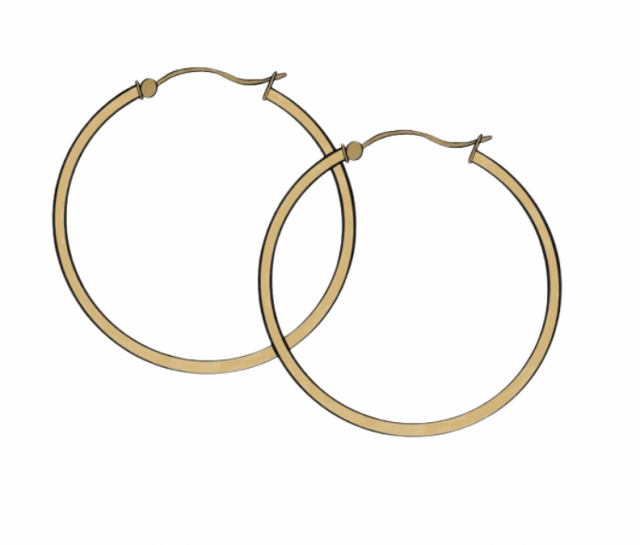
Wire hook earrings have various names. Some call them ‘fish hooks’, although various types of earrings feature longer wire hook closures and similar variations. Other names include ‘French hooks’ or ‘shepherd hooks’. In general, this particular style features wire that curves around and hooks in the ear lobe.
The main difference between wire hooks and other types of earring closures is the fact that this type does not feature any earring back.
This style of earring connects the fish hook with a decorative piece. They can vary in size, from dainty to extra-large. Based on their design, wire hook earrings can be of many types: drop, dangle, chandelier, and more. Due to their easy-to-wear system, wire hooks are versatile and perfect as on-the-go accessories.

Teardrop earrings are fixed on the lobe, generally with a push-back or wire hook closure. Their design is tear or pear-shaped. They are usually of medium size and they are part of the dangling earring family, although fixed styles are also available.
In jewelry design, teardrop has a special significance. The shape is usually associated with the idea of tears of joy and romanticism. This is why many engagement rings feature this cut! Similar to stud earrings, teardrop designs have a timeless, elegant appeal that is highly versatile and suitable for a wide range of occasions.


Dangle earrings are just as their name describes them: dangly. Never stationery (unlike their cousins, the drop earrings), dangle earring types are characterized by their continuous movement. Most pieces are on the longer side, but some daintier pieces with slim chains also qualify for this category.
Dangle earrings hang below the earlobe and can feature a variety of designs, from simple chains to tassels and from white dangle earrings suitable for brides to ornate gem-adorned styles. Extra-long designs can touch the shoulder and even the collarbone and they are often called ‘shoulder dusters’.


Drop earrings define the types of earrings that feature a longer and slimmer silhouette, usually with a gem at the bottom (hence the name ‘drop’). There are many styles available on the market, but the idea behind all is an earring design that hangs vertically below the ear.
Most styles of drop earrings feature a single stone, be it a pearl, diamond, or colored gemstone. They are usually simple, minimalistic, and not ornate, yet stand out with their elegant length. Some styles are dangly and mobile, while others are more sturdy and fixed.

C hoop earrings are hoops with a missing section. Resembling the letter C, these types of hoops have all the characteristics of a hoop, minus their closure type. Hoops usually come with wire closures, while C hoops usually feature push backs.
C hoop earrings come in a wide assortment of designs and can range considerably in size. Some of the most popular styles include slim metallic creations, thicker tube-like styles, designs enhanced with gemstones or pieces that emulate the look of a chain.

Tassel earring types feature actual fabric/string tassels or define the types of earrings that resemble a tassel by design. When crafted out of metal, tassel earrings usually include a multitude of slim chains that start from the same point, resembling an actual metallic tassel. Other styles include a multitude of earring findings adorned by tiny beads, mother of pearl charms or other ornaments.
Dangly, bouncy, and playful, tassel earrings are statement pieces. The most common types feature embroidery floss, but some are made out of lace or other textile materials.

Jacket earrings are a modern and innovative creation that usually features a latch or a gem in the front, while the larger part of the earring is found behind and under the ear.
Most designs feature a simple stud in the front (such as a zirconia or pearl stud), although more elaborate creations exist as well. The part that peeks from behind is more intricate, including floral designs, stars, or leaf motifs. Some might call them elevated studs, as they are a more complex version of a stud that is unique in design and that brings extra sparkle and visual interest.

Cluster earrings are pieces that display multiple gemstones that are grouped together. They can be studs (such as flower studs, where each petal features a different diamond or gem) or they can be dangly. The dangle cluster styles incorporate both multiple chains and multiple gemstones, such as pearls (pictured below).
Cluster studs are a contemporary alternative to simple studs, adding extra dazzle to any look. Cluster earrings are more elaborate than simple studs and are designed to make a dazzling statement.


A timeless piece of jewelry can go a long way. Whether paired with smart office outfits, relaxed weekend ensembles, with your Christmas outfits or New Years’ Eve attire, pearl earrings simply work in every situation and with many types of rings and necklaces.
Discover our collection of Pearl Earrings, featuring exquisite pieces that range from true classics to unique, modern designs. Studs, drop and dangle earrings, birthstone earrings, bridesmaid earrings and more – all in our premium collections and clearance specials!
Huggie earrings are miniature hoops. These types of earrings embrace the earlobe rather than hang below. They are circular in shape (similar to classic hoops) and occasionally resemble C-shaped hoops.
Compared to large hoops, huggies are more versatile and easier to wear with a wide range of hairstyles. Since they are on the tiny side, they do not interfere with hairdos and they stay safely in place. They have a discreet charm and they can be minimalistic (metal only) or adorned with a variety of gemstones.

Similar to English lock earrings, the leverback types of earrings refer to the closure type rather than the design. This type of closure comes with a hinged, closed mechanism, which provides high security.
The designs can range significantly, but most are on the small side, featuring the closure and an attached gemstone or a chain with a gemstone (example pictured below). Used widely in both fantasy and fine jewelry pieces due to the increased security of their mechanism.

Chandelier earrings get their name from the ornate and intricate light fixture. They are one of the large dangling styles, featuring a base on the lobe (a stud, wire hook, or clip-on), with elaborate filigree enhanced by gemstones ranging from diamonds to pearls, colored gems, rhinestones, and more.
Chandelier earrings find their origins in the Middle East, Greece, and India. Some of the oldest pieces were discovered in Greece and they are believed to date from the 5th century B.C. The design of these old chandelier earrings featured gold filigree styles with small shell lockets.

English lock earrings are popular types of earrings that mostly refer to the type of closure used, rather than the actual design. As one of the most popular types of closures, the English lock is very secure, featuring a thin hinged lever that folds out at the back of the ear.
Most designs include smaller styles, huggies, and partial huggies, or dainty dangle designs that feature gemstones like pearls. The lock provides high safety, which is why many fine jewelry pieces feature this type of earring back.

Threader earrings feature slim chains that go through the pierced ear and hang on each side of the lobe. Basically, threaders have a long post that serves a double purpose: style and safety. Fixed, non-dangly, and non-chain threader earrings are available as well.
Due to their slim silhouette, threader earrings are dangly and move as you move. Plus, most styles can be worn simultaneously in two-lobe piercings at the same time due to their flexible design. Oftentimes, they feature gemstones, geometric shapes, or metallic bars hanging on the front side.

Bajoran earrings get their unique name from Star Trek, where they were worn by humanoid species as a representation of their beliefs. Beings from the planet Bajor wore a type of earrings in one ear that denoted their devotion to their faith.
Bajoran pieces come with two connection points (similar to elaborate cuffs). One connection point is usually fixed on the lobe with some type of closure, while the other is placed on the upper ear and usually does not require a piercing. Most styles feature layered chains, with or without charms.
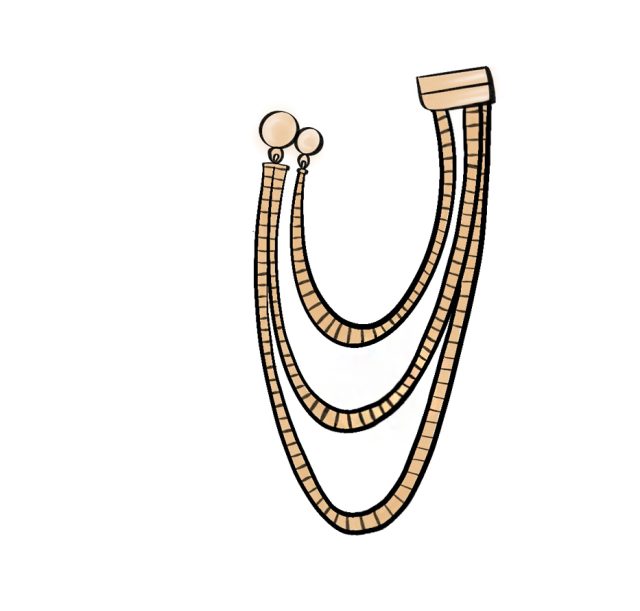
Ear cuffs are types of earrings that include two categories: pieces that resemble C hoops (only worn horizontally) and that can be worn without a piercing on various parts of the ear and statement designs that travel on the curve of the ear. Simple pieces are small and do not require pierced ears – and larger cuffs can contain multiple connection points, similar to Bajoran earrings.
Ear cuffs come with a long history. They originate in ancient history when they were worn by aristocrats as a status symbol. Called at some point the ‘Kaffa’ earrings, the first cuffs were crafted from brass and they were designed for the outside edge of the ear.
Statement cuffs were also popular during the ’40s and ’50s and many vintage pieces that are currently on the market are from said eras. In the ’50s, ear cuffs were worn in pairs, while these days, trends mostly dictate wearing a singular standout cuff.

Crawler earrings are often called ‘climber’ earrings. These types of earrings are fixed in the lobe piercing and literally ‘crawl’ or ‘climb’ up the ear.
Crawlers are definitely statement pieces and can be worn in a pair, mismatched with a daintier earring in the other ear, or just as a one-piece. There are various designs available, including pieces featuring leaf motifs, flowers, stars, or gemstones.
Crawler styles look best when paired up with shorter hair or updos since they are bold pieces of jewelry that aren’t meant to hide or be discreet.

Barbell earrings get their name from their similarity with a barbell shape, which includes a metallic bar and spheres on each end. Their closure is found in one of the spheres, which can be detached in order to be inserted in the ear.
They can be worn in a pair or as a standalone piece – and one barbell can be inserted in one piercing or in multiple piercings at the same time (industrial barbells).
Typically edgy and with a punky vibe, barbells can be worn in different ear piercings (and beyond) and they come in different gauges. When worn in the ear, their most common placement is across the cartilage.
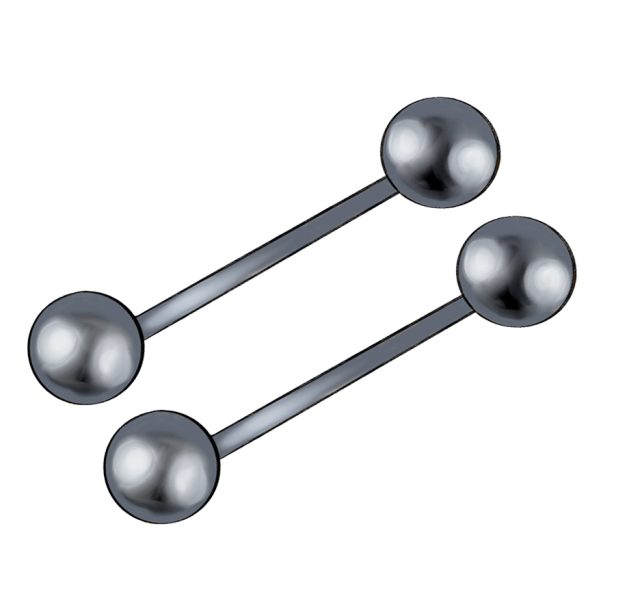
A circular barbell earring has the same features as a straight barbell, only in a rounded shape. Also commonly known as a horseshoe barbell due to its typical shape, this type of earrings/piercings features orbs at each end. One orb detaches in order to allow easy insertion, while the other does not. A second type of circular barbell exists, featuring one sphere – and they are often called ‘ball closure rings’.
Circular barbells are not destined exclusively to ear piercings – they are commonly worn as nose rings as well. Other than orbs, circular barbells can feature a variety of designs at each end, including stars, spikes, disks, or other elements.

Plug earrings cover two different types: double-sided earrings and plug piercings. In other words, faux plugs or real plugs that involve the process of ear stretching.
Faux plug earrings (pictured) are similar to barbell earrings in the sense that they feature a metallic cylinder that is inserted in the pierced ear and disks at each end, one of which is detachable.
Real plugs that involve expanding the pierced area are also called ‘flesh tunnels’ and ‘earspools’ and they have a cylindrical shape, available in different gauges.

FACT: Plug earrings have been common among many cultures. During the Egyptian New Kingdom Era, people wore large gauge earrings made out of wood, silver or gold, while Inca men wore precious metal plugs that symbolized their nobility.
Mismatched earrings are part of the modern earring types group. Basically, you get to wear two different earring designs – which can either match (theme-wise) or not resemble at all.
Examples of mismatched earrings with similar themes: star & moon earrings or “X” and O”. Alternatively, you can wear a minimal stud in one ear and a statement dangle piece (such as chandelier or shoulder duster types of earrings) in the other, with one thing in common: the setting, be it white or yellow gold.

Shoulder duster earrings are extra-long, dangly earrings that reach the shoulders. The term was first introduced to describe pendant earrings with a slimmer design during the Art Deco period. Some of the most popular pieces came from brands such as Cartier and Neil Lane, although most of them did not touch the shoulder.
They are obvious statement pieces that require no further adorning (such as with additional necklaces), as they stand out on their own. Designs include chains, filigree, gemstones that are usually placed in slim, linear designs (such as pearls set on chains).

Clip-on earrings are non-pierced types of earrings that can be worn by children and adults alike. This earring type does not require pierced ears and features a mechanism that applies pressure from each side of the earlobe. When worn properly, they do not cause any pain or damage to the ear, nor do they leave marks.
While these days, clip-on earrings are not at their peak of popularity, many decades of the past featured this earring style predominantly. During the 80s and 90s, various vibrantly colored statement clip-on earring styles were available on the market. And during the 1920s and 1950s in America, clip-on earrings were highly prevalent. The reason for the latter: pierced ears were considered an act of rebellion.

FACT: Between the 17th and 18th centuries, earrings virtually disappeared in Europe due to trending hairstyles and fashion of the era: hairdos that fully covered the ears and ultra-high ruff collars.

Earrings come in a varied selection of styles – and so do earring backs. Whether you’re simply interested to know more about jewelry in general, looking for the perfect gifts, or shopping for yourself, you need a quick mini-guide on the different types of earring closures. Next, we’re taking a look at some of the most common types of earring backs and the pros and cons for each.

Also called ‘wire hooks’, this style of earring backs refers to simple hooked wires without a metallic back. Occasionally, they feature tiny rubber backs for extra security. They are used in most casual, inexpensive designs, but daintier types of earrings in gold or platinum also feature this system.
Used for: Dangle styles, including drop and chandelier.
Pro: Inexpensive and very easy to put in and out.
Con: Losing earrings is possible, due to the fact that there is no back to the hook.

Push backs are the most popular type of earring backs. They are occasionally called ‘butterfly’ backs due to the design of the post. The name ‘push back’ comes from the simple move needed to secure the earring in place.
Used for: Both studs and dangly types of earrings.
Pros: Secure and easy to wear.
Cons: Not suitable for highly active people.

Hoops come with different closures: either lever backs, hinged closures, or simple hoop wires. Both hoops and huggies feature one of these types, but designs vary. Some closures are more noticeable, while other lever back hoop wires are more streamlined.
Used for: Hoops and huggies.
Pros: Streamlined, unnoticeable closure.
Cons: Can be damaged more easily than other closures.
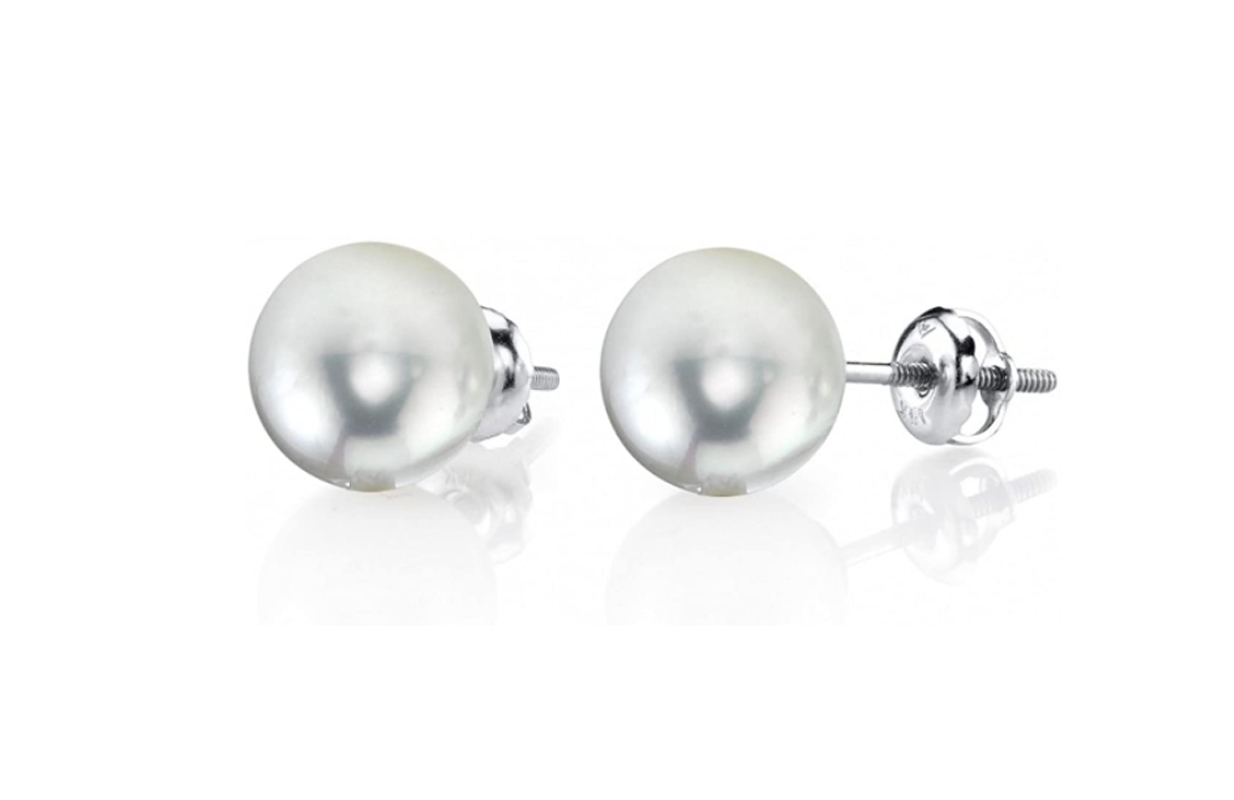
Screw back studs are types of earrings that feature a screw-like system, with a post that requires the back to be rotated until screwed safely. They need to be fully unscrewed when taking them off.
Used for: Studs, mostly fine jewelry.
Pros: Their back cannot be pulled off, so it provides extra security.
Cons: It can take a little longer to put them on and take them off.

Latch back earring backs (or English lock earrings) feature a post that attaches to a catch. There are various variations out there and designs differ based on the types of earrings. They mostly accompany dangly styles that carry some weight, including chandeliers and hoops.
Used for: Mostly heavier earring types.
Pros: Secure and safe.
Cons: Not as easy to put in and out as other styles.

Also called ‘saddlebacks’, these earring closures feature a curved post that is latched and locked. They offer high security for hoop-like styles, including huggies or off-round hoops in various geometric shapes.
Used for: Hoops, huggies, and other circular styles.
Pros: Secure feel, easy to wear.
Cons: The system can be damaged after prolonged wear.

Long hooks are generally similar to wire hooks, although in this case, the hook is part of the earring design. Long or extra-long, these types of earrings resemble threaders, where both the design in the front and in the back of the ear serve an aesthetic purpose.
Used for: Dangling styles, drop earrings, non-flexible threaders.
Pros: A streamlined look without an apparent closure.
Cons: Easier to fall off than other styles with a backing.
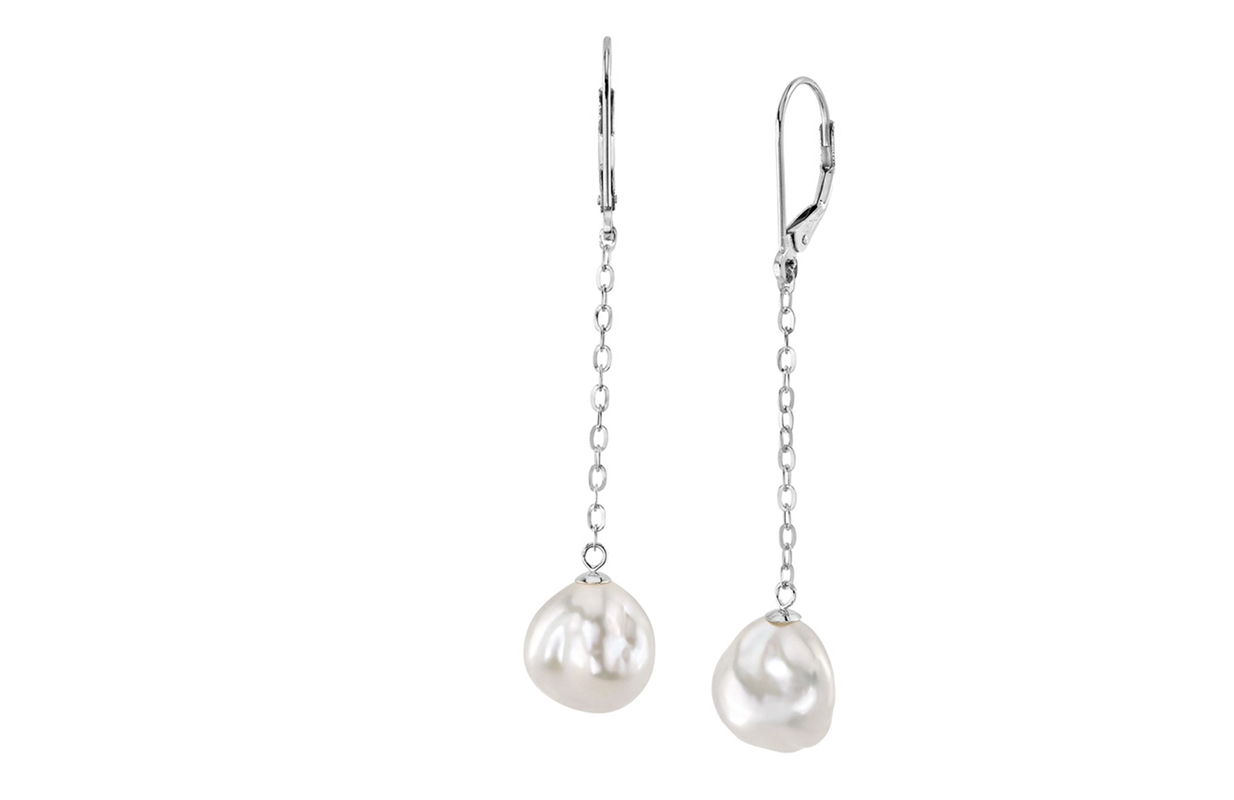
Lever backs somewhat resemble latch backs in the sense that they both have a similar hinged post and catch in the back. They feature a curved wire instead of a straight post, plus a hinged lever piece as a closure.
Used for: Dainty styles (like a hanging stud) and dangly earrings.
Pro: Easy to wear and hassle-free.
Con: If you want earrings with hidden closure, these types are not recommended because the earring back is more visible.

Whether you’re going for dangle, drop, or chandelier earrings, pair your ear bling with a versatile neckpiece: a chic pearl pendant featuring radiant gems of the sea. Browse our Pearl Pendants collection and find your perfect pearls – classic whites, colored or dark and iridescent, the right mens pearl necklace, dainty and round or unique baroque gems.
A true classic, pearl pendants look cohesive with any looks from your closet, from casual ensembles and office outfits to sophisticated eveningwear. And more than that, they make stunning anniversary jewelry for your loved one.
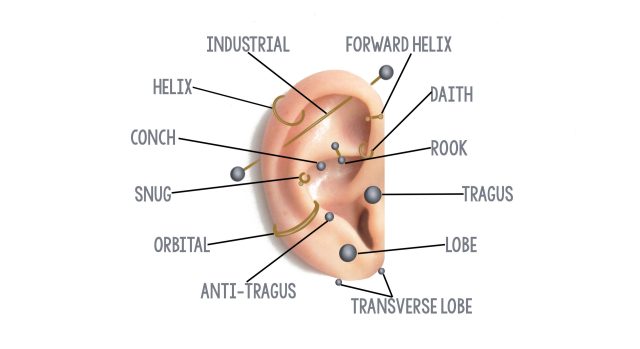
Earrings can add that extra something to any look: a glimpse of sparkle, iridescence, glow or simply fierceness (we’re thinking Bajorans and cuffs). But so can piercings, with an extra dose of edge and industrial feel. Below, we’re looking at the main types of ear piercings, their placement on the ear, and their main characteristics.
The lobe piercing is the ultimate classic and by far the most common type of all ear piercings. Both adults and children sport earlobe piercings – usually one on each side, but multiple lobe piercings in one ear are common as well. The earlobe represents the lower section of the ear, which is the least painful part of the ear when pierced. The lobe piercing welcomes all types of earrings, from simple studs to rings, dangle styles, and chandeliers.
Tragus ear piercings are found on the outer cartilage. These types of piercings are placed in the area of the triangular flap, which is an area much thicker and harder than the lobe because it contains cartilage. If you are opting for a tragus piercing, make sure you have it done by a professional, as the area is very close to the ear canal and the procedure needs a lot of attention.
Rook piercings are found in the cartilage of the upper ear. This type of piercing gets its name from the fact that it’s a vertical style, resembling the rook piece in chess. The similarity is obvious, especially when opting for barbell-type piercings. Due to its verticality, a rook piercing allows the rings to face downwards.
The daith is found in the inner fold, between the tragus and the rook piercings. Similar to the tragus piercing, the daith piercing is very close to the ear canal. Most suitable earrings include rings or barbells.
Forward helix piercings are found above the tragus, on the curve of the ear. Technically, they are considered helix piercings and are usually paired up with other helix rings.
The most common type of industrial ear piercing is the one that pierces both the helix and the antihelix. Industrial ear piercings are definite statement pieces with a strong industrial look, just as their name suggests.
Helix piercings are positioned on the upper cartilage of the ear or anywhere on the outer edge. Because it’s a larger area, many piercing lovers opt for double or triple forward helix piercings.
Conch piercings are positioned on the middle section of the ear. You can opt for either an inner conch on the lower cartilage or an outer conch piercing in the upper cartilage.
Snug piercings are less common – and the fact that they are among the most painful types is one of the reasons. They are placed on the area between the inner and outer portions of the ear.
Orbital piercings refer to any piercings that feature two holes in the same part of the ear, with an earring (usually a huggie / hoop) that goes through both. A single ear piercing can easily become an orbital one when another piercing is added next to it.
An anti-tragus piercing is found on the outer cartilage area, opposing the tragus piercing. The anti-tragus defines the small vertical lip of cartilage which is found above the earlobe.
Transverse lobe piercings are usually small and found on the earlobe. However, unlike the classic lobe piercing, transverse types do not pass from the front and go out the back of the ear, but both ends are found on the same side of the ear.
Studs are the most popular types of earrings. Simple, discreet, and elegant, studs are versatile and appropriate for the widest range of occasions and looks, including casual ensembles, office outfits, eveningwear and as bridal earrings. Fine jewelry suds are also sustainable fashion-approved, due to their timeless appeal that goes beyond trends. Other popular earring types include dangle earrings, hoop earrings (including the trending pearl hoop earrings), and huggies.
Stud earrings feature push backs, also called ‘butterfly backs’ or simply ‘posts’. A push back is a tiny metallic piece that is pushed into the earring’s post. Fine jewelry studs sometimes come with screw backs for extra security. Certain types of studs feature rubber backings instead of metallic ones (uncommon for fine jewelry).
If statement necklaces peaked a few seasons ago, in 2024, it’s all about statement earrings. Doing a little Christmas shopping? Whether you’re hunting for gifts for grandma, for sis, mom, or for yourself, the current jewelry trends indicate that unique and larger styles are IN this ear. These include prominent tube hoops, dangle pearl earrings, mismatched earrings, sculptural pieces, and pearl earrings in modern designs.
Earrings can definitely make an outfit. And they’ve been doing just that for thousands of years. Elegant. Glam. Sparkly. Playful. Fierce. Or all in one. A dainty and discreet touch of shimmer, a dangling pair that moves as you move or an edgier cuff are all chic choices, depending on the occasion. Which one is your favorite type of earrings? Are you a minimalist vibing with staples like classic studs? Or are you a maximalist bling lover, all about a good pair of chandelier earrings or a complex ear party? Or perhaps a lover of non pierced pieces and a chic ear cuff? Let us know in the comment section below!

They’re a daytime staple and perfectly appropriate for elegant evening affairs at the same time. They’re dainty, discreet, yet radiant and unapologetically chic. Stud earrings are, without a doubt, a style staple without an expiration date.
Our collection of pearl-adorned designs features the widest range of both classic and modern styles. Have your pick from Freshwater Pearls, Akoya Pearls, South Sea and Tahitian Pearls for timelessly elegant style wherever you go – from the office to the cocktail party.
Signup now and receive an email once I publish new content.